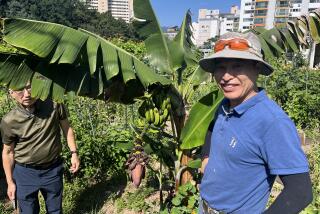<i> Musa </i> hybrids : Edible banana : Fast-growing, fruit-bearing, ornamental plant
- Share via
Southern California has many microclimates, but on the whole, the area is very good for growing bananas at home.
Most edible banana varieties are the result of mixed parentages of Musa . The most successful Musa hybrids available in our area are: “Ice Cream,” 15 to 20 feet with light green leaves, a vigorous grower producing medium bunches of 4-inch bananas; “Manzano,” 15 to 20 feet, vigorous, a rapid grower and producer of large bunches of fruit 3 to 6 inches long; “Orinoco,” 12 to 16 feet, the hardiest, producing medium bunches of short, fat, angular plantain-like bananas. “Dwarf Cavendish,” 6 to 9 feet, with dark-green leaves and sweet bananas, is not such a reliable producer, but can be planted in containers.
Now is the best time to plant bananas, when the soil temperature is between 65 and 75 degrees. Your nursery can order any of the above varieties from San Marcos Growers in Santa Barbara. Or take a trip to Richardson’s Seaside Banana Garden, near Ventura. Telephone first: (805) 643-4061.
In general, the plants should be situated on the lee side of a hedge, tall trees or buildings. They need rich, moist, but well-drained soil.
To get your plant to fruit, let the tallest stem grow, plus two or three suckers (these will take the place of the fruit-bearing stem after it produces fruit). Stake the main trunk while it is flowering to hold the future bananas. After the stem has fruited, cut it to about 4 feet and leave it for a few months. When it starts to decompose it can be cut down. With most varieties, you have to wait only 1 1/2 years for the first bunch; then the plant will produce annually after that.
Control mites by washing down the leaves or by applying insecticidal soap. Watch for gophers, which love the banana corms the way we love bananas.






